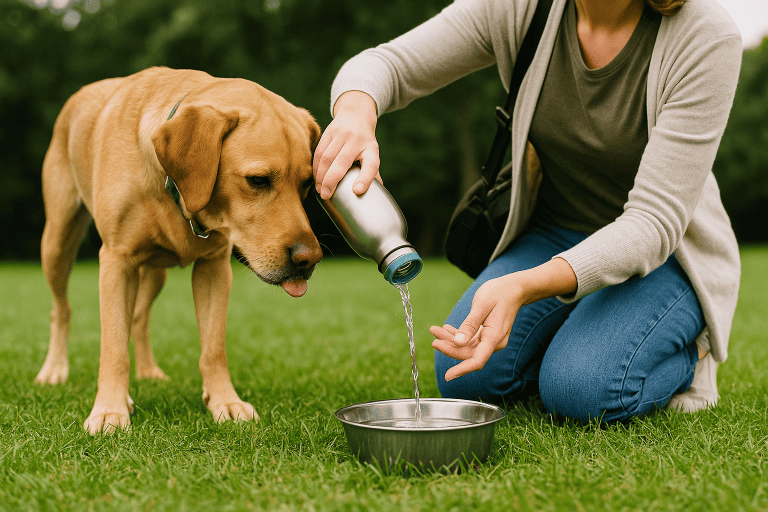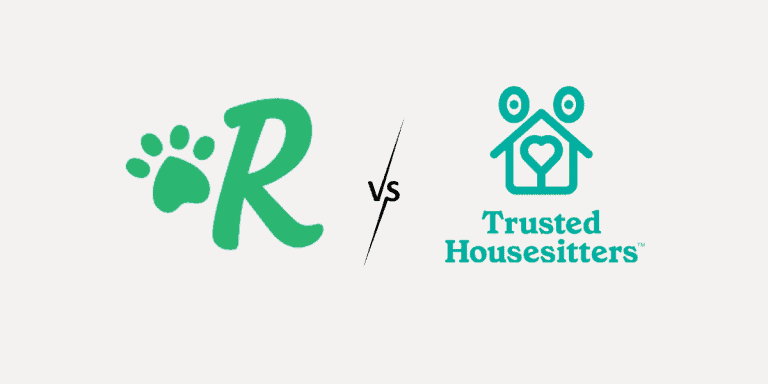At-Home Pet Sitting: The Ultimate Guide for 2024

If I had a pound for every household with a dog in the UK, I’d have about £12 million quid. I’d have about the same again if you added cats. With so many pets living with us in our homes, the demand for a safe place to leave our furry (or feathered, or scaly) friends when we go away has never been higher.
While traditional kennels and catteries still have their place, many pet owners are turning to at-home pet sitting services as an alternative when they can’t be at home to look after their pets themselves.
It’s important to understand the commitment you’ll be undertaking if you choose to start an at-home pet sitting business. If you were in a burning building with a dog, you better believe the owner is saving the pooch before they come back for you. To most owners, pets are an extension of their own family and they expect you to treat them as such.
My point is this: only consider becoming an at-home pet sitter if you’re prepared to actively do the work to keep the pets in your care happy, healthy and safe while they’re with you.
In this post, I’ll talk you through everything you need to know about at-home pet sitting, and help you decide if it’s right for you.
What is At-Home Pet Sitting?
At-home pet sitting is a service where animal lovers care for pets in their own homes while the owners are away. It’s become increasingly popular in recent years, offering a cosy alternative to kennels or catteries. Let’s break down what this pet care option involves and why it’s gaining traction among pet owners and animal enthusiasts.
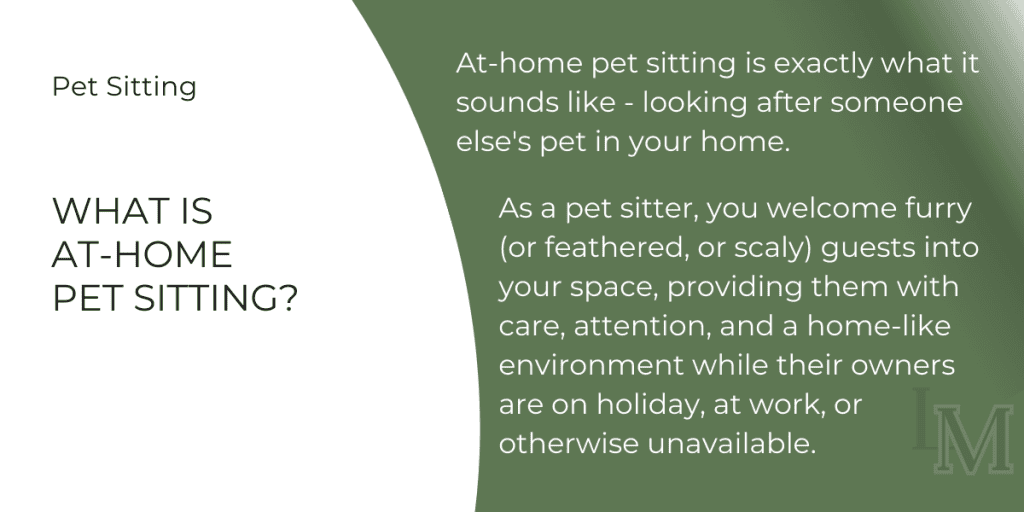
This service can range from daytime care to overnight stays, depending on the owner’s needs. Some pet sitters specialise in certain types of animals, while others are happy to host a menagerie of different pets.
How At-Home Pet Sitting Differs From Other Pet Care Services:
Location: Unlike traditional boarding facilities or pet hotels, at-home pet sitting happens in a real home environment. This can be less stressful for many animals, especially those who get anxious in unfamiliar surroundings.
Personalised attention: While kennels and catteries do their best, they often can’t provide the one-on-one attention that an at-home pet sitter can. You’re able to give each pet individual care and companionship.
Flexibility: At-home pet sitting often offers more flexible schedules than fixed-hour doggy daycare centres or boarding facilities. This can be handy for pet owners with irregular work hours or travel plans.
Familiar routines: In your home, you can more easily stick to a pet’s usual routines for feeding, walking, and playtime, which helps reduce stress for the animal.
Benefits for Pets and Owners
For pets:

- Less stress: Staying in a home environment is often calmer for pets than a busy kennel.
- Consistent care: Pets receive dedicated attention from one person rather than multiple staff members.
- Maintenance of routines: Regular feeding, walking, and play schedules can be more easily maintained.
- Socialisation: For some pets, interacting with the pet sitter and potentially other animals can be beneficial.
For owners:
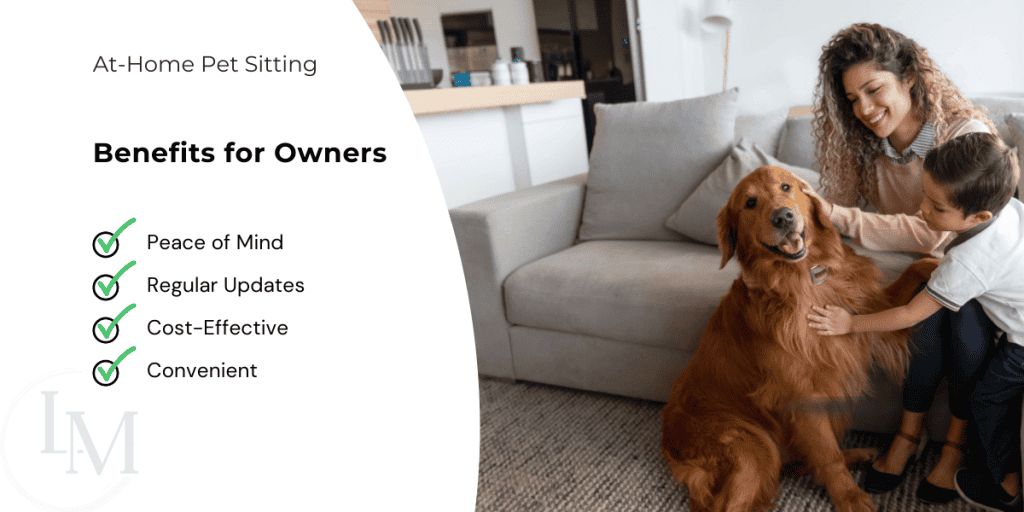
- Peace of mind: Knowing their pet is in a home environment can be reassuring for many owners.
- Regular updates: Most at-home pet sitters provide frequent updates, often including photos or videos.
- Cost-effective: Depending on the area, at-home pet sitting can be more affordable than luxury boarding facilities.
- Convenience: Pet owners don’t need to transport their pets to and from a boarding facility.
At-home pet sitting is more than just a job – it’s a responsibility that requires love, patience, and a genuine fondness for animals. As a pet sitter, you’re not just providing a service; you’re offering peace of mind to pet owners and a home away from home for their beloved companions.
Getting Started as an At-Home Pet Sitter
Becoming an at-home pet sitter can be both exciting and a bit nerve-wracking. But don’t worry – with the right preparation, you’ll be ready to provide top-notch care for furry friends in no time. Let’s break down the essentials you’ll need to get your pet sitting business off the ground.
Essential Skills and Qualifications
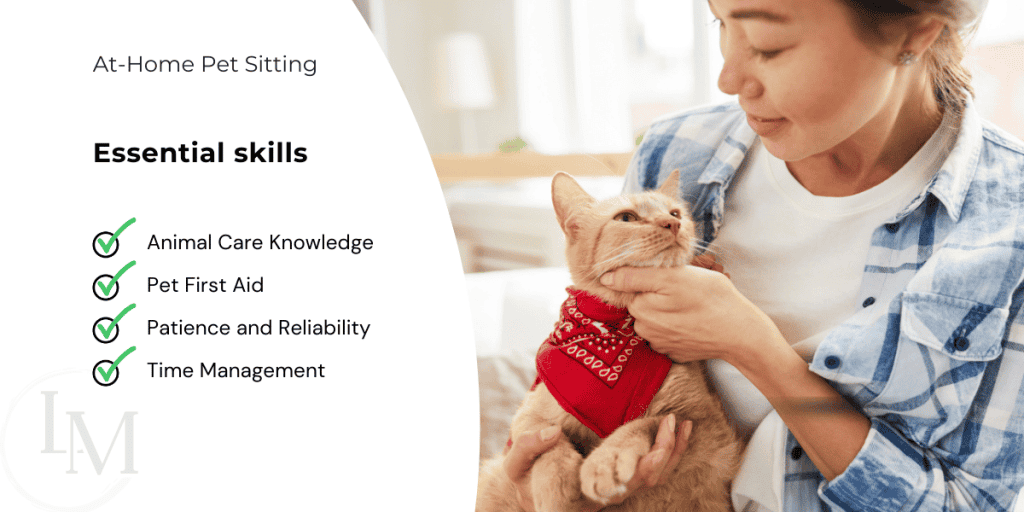
Before you dive into pet sitting, it’s important to assess your skills and qualifications. While a love for animals is a great start, there’s more to consider:
Animal care knowledge: You should have a solid understanding of basic animal care, including feeding, grooming, and exercise needs for different types of pets.
First aid skills: Consider taking a pet first aid course. Knowing how to handle minor injuries or emergencies can make a huge difference.
Patience and reliability: Pets can be unpredictable, so you’ll need to stay calm under pressure and be consistent in your care routine.
Time management: Juggling multiple pets and clients requires excellent organisational skills.
If you’re lacking in any of these areas, don’t fret. There are plenty of online courses and resources available to help you brush up on your skills.
Setting Up Your Pet Sitting Space
Creating a safe and comfortable environment for your furry guests is crucial. Here’s what you need to consider:
Pet-proofing: Look at your home from a pet’s perspective. Remove or secure any potential hazards like toxic plants, loose wires, or small objects that could be swallowed.
Designated areas: Set up specific spaces for feeding, play, and rest. This helps maintain a routine and keeps things organised.
Outdoor space: If you have a garden, make sure it’s securely fenced to prevent escapes.
Remember, your space doesn’t need to be huge, but it should be clean, safe, and welcoming for pets of all sizes.
Essential Equipment and Supplies
Having the right tools on hand will make your job much easier. Here’s a basic list to get you started:

As you gain more experience, you’ll likely add to this list based on the specific needs of the pets you choose to look after.
Insurance and Legal Considerations
While it might not be the most exciting part of starting your business, getting the legal bits sorted is important:
Insurance: Look into pet sitting insurance. This can protect you if a pet is injured in your care or causes damage to property.
Business registration: Depending on your location, you might need to register your pet sitting business. Check with your local council for specific requirements.
Contracts: It’s a good idea to have a basic contract outlining your services, rates, and policies. This helps avoid misunderstandings with clients.
Building Your Reputation
Like with most businesses, you’ll struggle to thrive if your customers don’t trust you.. Here are some ways to start building a solid reputation:
Start small: Begin by offering your services to friends and family. This allows you to gain experience and collect testimonials.
Online presence: Set up social media accounts for your business. Share photos (with owner permission) and tips to showcase your expertise.
Network: Join local pet-related groups or forums. Building connections in the pet community can lead to referrals.
If you want to look a little deeper into bow to build trust with your customers, I have a full article dedicated to this very subject right here!
Preparing for Your First Pet Sitting Job
Getting ready for your first pet sitting gig can be exciting and a bit nerve-wracking. But with the right preparation, you’ll be set up for success. Let’s walk through the essential steps to ensure you’re fully prepared to provide top-notch care.
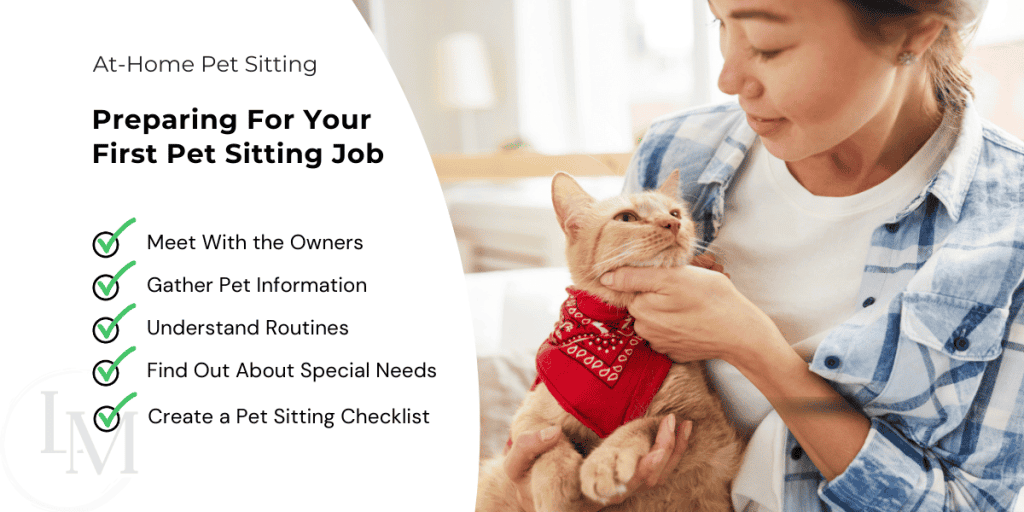
Initial Consultation with Pet Owners
Your first meeting with potential clients is crucial. It’s your chance to make a good impression and gather vital information about the pet you’ll be caring for.
Here’s how to make the most of this meeting:
Meet in person: If possible, arrange a meet and greet before you accept a booking. This allows you to see the pet in its natural environment and observe its behaviour.
Ask questions: Don’t be shy about asking for details. The more you know, the better care you can provide. Some key questions to ask include:
- What’s the pet’s daily routine?
- Does the pet have any health issues or allergies?
- Are there any behavioural quirks or challenges I should be aware of?
- What’s the pet’s favourite toy or activity?
Meet the pet: Spend some time interacting with the pet during this initial meeting. This helps you gauge its personality and comfort level with you.
Gathering Important Information About the Pet
After your initial meeting, make sure you have all the necessary details about the pet.
Create a pet profile that includes:
Basic info: Name, age, breed, and any identifying marks or microchip numbers.
Health information: Vet contact details, any current medications or health issues, and vaccination records.
Feeding schedule: What, when, and how much the pet eats. Don’t forget to ask about treats!
Exercise needs: How often the pet needs walks or playtime, and any favourite activities.
Emergency contacts: Get the owner’s contact information, as well as a backup contact in case you can’t reach the owner.
Understanding the Pet’s Routine and Special Needs
Pets thrive on routine, so it’s important to stick as closely as possible to their normal schedule.
Pay attention to:
Daily schedule: Note down the usual times for meals, walks, and other activities.
Comfort items: Ask about the pet’s favourite toys, beds, or other items that help them feel at ease.
Special instructions: Some pets might need extra care, like regular grooming or medication. Make sure you’re clear on any special requirements.
Creating a Pet Sitting Checklist
A well-organised checklist can be a lifesaver, especially when you’re just starting out. Here’s what to include:
Daily tasks: List all the regular activities you need to do each day, like feeding, walking, and playtime.
Emergency information: Keep vet contact details, emergency numbers, and the pet’s medical info easily accessible.
House rules: Note any specific instructions about the pet’s behaviour or access to certain areas of your home.
Owner updates: Plan how and when you’ll update the pet owners. Many appreciate daily photos or messages about their pet’s wellbeing.
Supplies inventory: Keep track of food, treats, and other supplies to ensure you don’t run out.
By following these steps, you’ll be well-prepared for your first pet sitting job. Remember, every pet is unique, so stay flexible and ready to adapt to their individual needs.
Daily Responsibilities of an At-Home Pet Sitter
As an at-home pet sitter, your days will be filled with a variety of tasks to ensure the health, happiness, and safety of the pets in your care. Let’s break down the key responsibilities you’ll need to tackle on a daily basis.
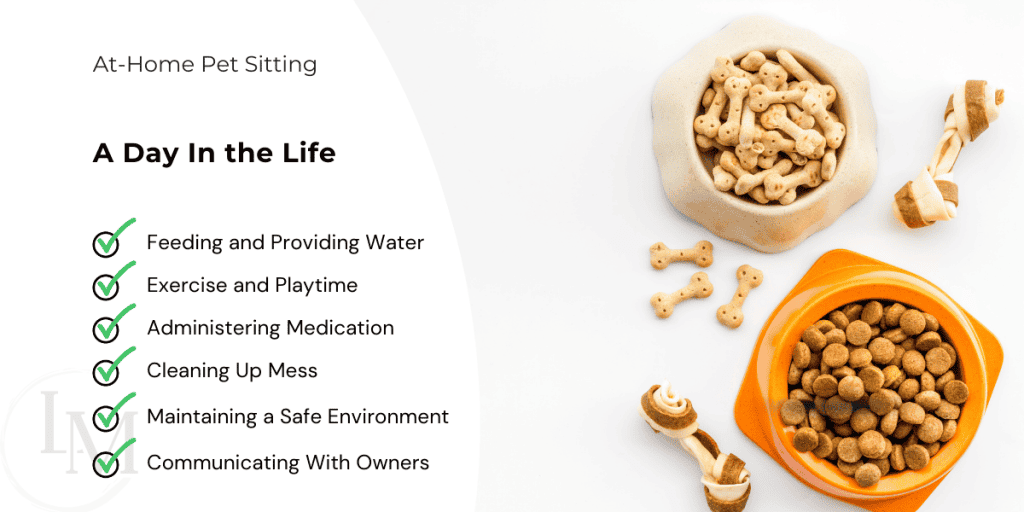
Feeding and Providing Fresh Water
One of your most important tasks is making sure that the pets in your care are well-fed and hydrated:
Stick to schedules: Follow the feeding schedule provided by the pet owner. Some pets eat twice a day, others graze throughout the day.
Measure portions carefully: Use the recommended amount of food for each pet. Overfeeding can lead to health issues.
Clean bowls regularly: Wash food and water bowls daily to prevent bacteria growth.
Fresh water always: Make sure clean water is available at all times. Some pets, especially cats, can be picky about their water source.
Exercise and Playtime
Keeping pets active and entertained is crucial for their physical and mental well-being:
Dog walks: Most dogs need at least one good walk per day. The length and intensity will depend on the dog’s age, breed, and fitness level.
Indoor play: For cats and small animals, set aside time for interactive play. This could involve toys, laser pointers for cats, or supervised out-of-cage time for small pets.
Mental stimulation: Use puzzle toys or hide treats around the house to keep pets mentally engaged.
Remember, a tired pet is often a well-behaved pet, so don’t skimp on the exercise and play!
Administering Medications (If Required)
If a pet needs medication, this becomes a top priority in your daily routine:

Follow instructions precisely: Make sure you understand the dosage, timing, and method of administering any medications.
Keep a log: Record when you give medications to ensure nothing is missed or doubled.
Be observant: Watch for any side effects or changes in behaviour after administering medication.
Cleaning Litter Boxes or Outdoor Areas
Maintaining a clean environment is essential for the health and comfort of the pets:
Litter boxes: Scoop cat litter boxes at least once a day, more if you’re caring for multiple cats.
Dog waste: Pick up after dogs, whether in your garden or during walks.
Small animal cages: Clean cages for rabbits, guinea pigs, or other small pets according to the owner’s instructions.
Providing Companionship and Attention
Pets need more than just food and exercise – they need love and attention too:
Quality time: Spend one-on-one time with each pet. This could be cuddle time on the sofa or just sitting near them while they relax.
Observe behaviour: Pay attention to each pet’s mood and behaviour. Are they eating well? Playing normally? Any signs of stress or illness?
Comfort anxious pets: Some pets may feel anxious without their owners. Offer extra comfort and reassurance to these animals.
Maintaining a Safe Environment
Safety should always be top of mind:
Secure the premises: Double-check that doors and windows are closed and locked when you leave or go to bed.
Remove hazards: Keep an eye out for potential dangers like small objects pets could swallow or toxic plants.
Monitor outdoor time: If pets have access to a garden, make sure they’re supervised and the area is secure.
For a deeper look at how make your home safe for pets, check out this guide.
Communicating with Pet Owners
Keeping in touch with the pet owners is a key part of your job:
Daily updates: Send a brief update to the owners each day. A photo or short video can provide extra reassurance. To level up your communication, create a pet-sitting report card.
Report any issues: If you notice any health or behaviour concerns, let the owners know promptly.
Ask questions: Don’t hesitate to reach out if you’re unsure about anything. It’s better to ask than to guess.
Handling Common Pet Sitting Challenges
As an at-home pet sitter, you’ll come across situations that test your skills and patience. Being prepared for these challenges will help you provide the best care possible and keep both pets and their owners happy. Let’s explore some common issues and how to handle them effectively.
If you want to look into this topic in a little more depth, I have a dedicated article here.
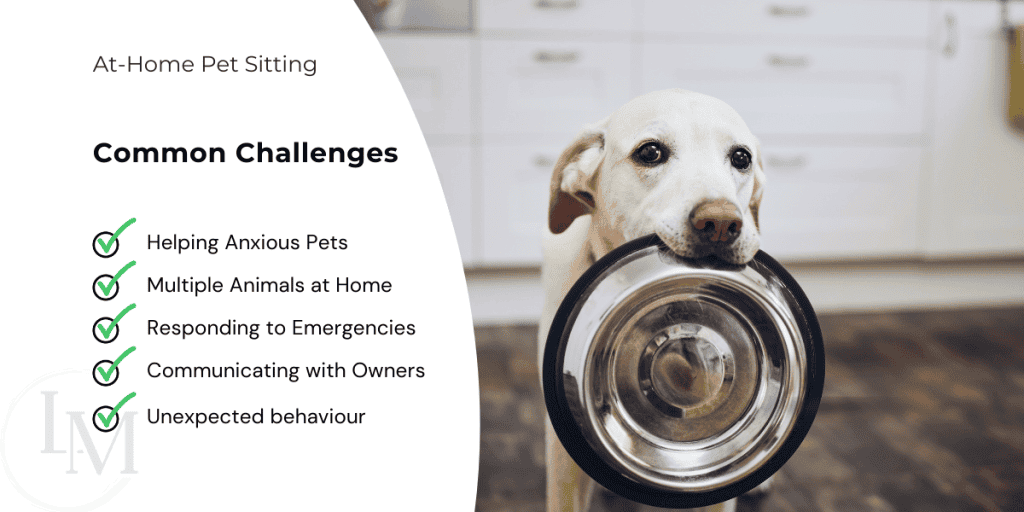
Dealing with Anxious or Stressed Pets
Many pets can feel uneasy in a new environment or when separated from their owners. Here’s how to help them settle in:
Create a calm environment: Set up a quiet, cosy space where the pet can retreat if feeling overwhelmed. Soft bedding and familiar items from home can help.
Stick to routines: Follow the pet’s usual schedule as closely as possible. Consistency can be very reassuring for anxious animals.
Use positive reinforcement: Reward calm behaviour with treats, praise, or playtime. This helps create positive associations with their stay.
Consider anxiety aids: With the owner’s permission, you might use calming products like pheromone diffusers or anxiety wraps.
Remember, patience is key. Some pets may take a day or two to fully settle in, so don’t be discouraged if they’re not immediately at ease.
Managing Multiple Pets in One Household
Caring for several pets at once can be challenging, but with the right approach, it can also be rewarding:
Understand each pet’s needs: Some pets might require more attention or have specific care routines. Make sure you’re clear on each animal’s requirements.
Establish a pecking order: If you’re feeding multiple pets, feed them in the order their owners do at home. This can prevent conflicts over food.
Supervise interactions: When caring for pets from different households, always supervise their playtime together. Not all pets will get along, so be prepared to separate them if needed.
Give individual attention: Make sure each pet gets some one-on-one time with you. This can help prevent jealousy and ensure all pets feel cared for.
Responding to Emergencies
Even with the best preparation, emergencies can happen.
Here’s how to handle them:
Stay calm: Your demeanour can influence the pet’s stress level. Take a deep breath and approach the situation calmly.
Have a plan: Keep emergency contact numbers (vet, pet owner, poison control) easily accessible. Know the quickest route to the nearest emergency vet clinic.
Know basic first aid: Being able to perform basic first aid can be crucial. Consider taking a pet first aid course to prepare yourself.
Communicate promptly: If an emergency occurs, contact the pet owner as soon as it’s safe to do so. Be honest about what happened and what steps you’ve taken.
Communicating with Pet Owners While They’re Away
Clear communication is vital for building trust with pet owners:
Set expectations: Before the stay begins, agree on how often and through what means you’ll update the owner.
Be honest: If issues arise, be upfront about them. Most owners appreciate honesty and will work with you to find solutions.
Share positive moments: Send photos or videos of the pet enjoying their stay. This can reassure owners and make them feel connected to their pet.
Respond promptly: If an owner reaches out with questions or concerns, try to respond as quickly as possible to allay any worries they might have.
Dealing with Unexpected Behaviour
Pets can sometimes behave differently in a new environment:
Be observant: Watch for signs of stress or discomfort that might lead to behaviour changes.
Stick to house rules: If the owner has specific rules (like no pets on furniture), try to maintain these to avoid confusion when the pet returns home.
Address issues promptly: If a pet develops a habit like excessive barking or inappropriate elimination, try to identify the cause and address it quickly.
Keep detailed notes: Document any behaviour changes or issues. This information can be valuable for the pet owner and may help identify patterns.
Remember, every pet is unique, and what works for one might not work for another. The key is to remain flexible, patient, and attentive to each pet’s individual needs. With experience, you’ll develop a toolkit of strategies to handle various challenges that come your way.
Best Practices for Exceptional Pet Care
Providing top-notch care for pets is about more than just meeting their basic needs. It’s about creating a safe, loving environment where they can thrive. Let’s explore some best practices that will help you stand out as an exceptional pet sitter.

Creating a Safe Environment for Pets
Safety should always be your top priority when caring for someone else’s beloved pet:
Pet-proof your space: Before welcoming a new pet, scan your home for potential hazards. Look for:
- Toxic plants
- Small objects that could be swallowed
- Loose wires or cords
- Open windows or unsecured doors
Secure outdoor areas: If you have a garden, make sure it’s fully fenced and free from escape routes. Check for gaps or weak spots regularly.
Keep harmful substances out of reach: Store cleaning products, medications, and other potentially dangerous items in locked cabinets or high shelves.
Use appropriate restraints: When walking dogs, use proper leashes and harnesses. For cats or small animals, use secure carriers during transport.
Maintaining Cleanliness and Hygiene
A clean environment is crucial for pet health and comfort:
Regular cleaning schedule: Set up a routine for cleaning food bowls, litter boxes, and pet bedding. This helps prevent the spread of bacteria and keeps odours at bay.
Proper waste disposal: Always clean up pet waste promptly, both indoors and outdoors. Use designated bins for disposal to maintain a hygienic environment.
Grooming: Brush pets regularly if the owner approves. This not only keeps them clean but also allows you to check for any skin issues or unusual bumps.
Hand hygiene: Wash your hands thoroughly before and after handling pets, their food, or their waste. This protects both you and the pets from potential infections.
Observing and Reporting Changes in Pet Behaviour or Health
As a pet sitter, you’re often the first to notice if something’s not quite right:
Know the pet’s normal behaviour: During your initial meeting, ask the owner about the pet’s typical behaviour, eating habits, and activity levels.
Keep a daily log: Note down the pet’s eating habits, bathroom routines, and general mood each day. This makes it easier to spot changes.
Watch for warning signs: Be alert for symptoms like:
- Loss of appetite
- Unusual lethargy
- Excessive thirst
- Vomiting or diarrhoea
- Changes in urination habits
Report concerns promptly: If you notice anything unusual, don’t hesitate to contact the pet owner or the designated emergency contact.
Providing Updates and Peace of Mind to Pet Owners
Regular communication is key to building trust with pet owners:
Daily updates: Send a brief message to the owner each day. Include details about the pet’s activities, mood, and any notable events.
Photo and video updates: A picture is worth a thousand words. Sending photos or short videos of the pet playing or relaxing can provide great reassurance to owners.
Be honest: If there are any issues or concerns, communicate them clearly and promptly. Owners appreciate honesty and proactive communication.
Respect privacy: While updates are important, respect the owner’s preferences for how often and in what manner they want to receive them.
Tailoring Care to Individual Pet Needs
Every pet is unique, and exceptional care means adapting to their individual requirements:
Follow owner instructions: Pay close attention to the specific care instructions provided by each pet owner. They know their pet best.
Adapt to personalities: Some pets are outgoing and playful, while others are shy or anxious. Adjust your approach based on each pet’s temperament.
Respect boundaries: Not all pets enjoy the same level of interaction. Respect their space and let them come to you on their own terms.
Enrichment activities: Provide mental stimulation through puzzle toys, treat-dispensing games, or new experiences (with owner approval).
Building Your Pet Sitting Business
Starting and growing a successful pet sitting business takes more than just a love for animals. It requires planning, marketing savvy, and excellent customer service. Let’s explore some key strategies to help you build a thriving pet sitting enterprise.
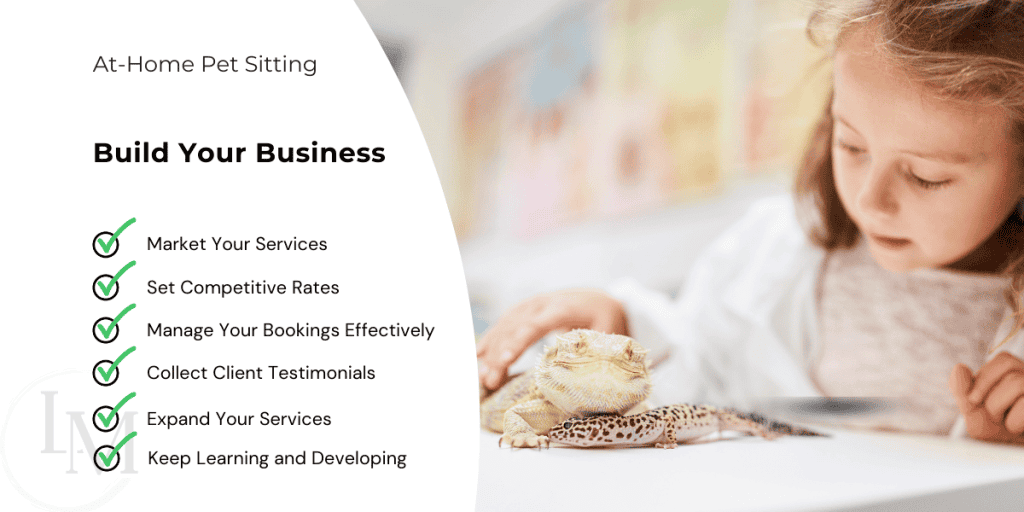
Marketing Your Services
Getting the word out about your pet sitting business is the best way to attract clients. Here’s how to effectively market your services:
Create a strong online presence: Set up a professional website that showcases your services, rates, and qualifications. Include photos of happy pets you’ve cared for (with owner permission, of course).
Use social media: Platforms like Instagram and Facebook are perfect for sharing cute pet photos and care tips. This helps potential clients see your expertise and personality.
Network locally: Join local pet owner groups on social media. Attend pet-related events in your area to meet potential clients face-to-face.
Offer referral incentives: Encourage satisfied clients to spread the word by offering a discount for successful referrals.
Consistency is key in marketing. Regular posts and updates keep your business visible and engaging.
Check out our article on 7 ways to market your pet sitting business for free for some ideas to get you started.
Setting Competitive Rates
Pricing your services can be tricky. You want to be competitive, but also ensure you’re fairly compensated for your time and effort:
Research local rates: Look into what other pet sitters in your area are charging. This gives you a baseline to work from.
Consider your costs: Factor in expenses like travel, supplies, and insurance when setting your rates.
Offer package deals: Create pricing packages for regular clients or extended stays. This can encourage repeat business.
Be transparent: Clearly communicate your rates and what services are included to avoid misunderstandings.
Don’t be afraid to adjust your rates as you gain experience and build your reputation. Quality service often commands higher rates. For more information, check out this article on how much to charge for your pet sitting services.
Managing Bookings and Scheduling
Efficient booking and scheduling systems are essential for running a smooth operation:
Use scheduling software: Consider using pet sitting software or apps that help manage bookings, client information, and invoicing.
Set clear policies: Establish and communicate policies for bookings, cancellations, and payments. This helps avoid conflicts and ensures smooth operations.
Be realistic about your availability: Don’t overbook yourself. Quality care is more important than quantity of clients.
Plan for emergencies: Always have a backup plan, such as a trusted fellow pet sitter, in case you fall ill or have an emergency.
Collecting and Using Client Testimonials
Positive reviews from happy clients can be incredibly powerful in growing your business:

Ask for feedback: After each pet sitting job, politely ask clients if they’d be willing to provide a testimonial.
Make it easy: Provide a simple way for clients to leave reviews, whether it’s on your website, Google Business profile, or social media pages.
Showcase testimonials: Feature glowing reviews prominently on your website and marketing materials.
Respond to all reviews: Thank clients for positive reviews and address any negative feedback professionally and constructively.
For a more in depth look at gathering reviews and testimonials, check out this dedicated article!
Expanding Your Services
As your business grows, consider expanding your offerings to attract more clients:
Offer additional services: Think about adding services like dog walking, pet taxi, or basic grooming to your repertoire.
Specialise: Consider getting certified in caring for specific types of pets or animals with special needs. This can set you apart from competitors.
Holiday services: Offer special packages for busy holiday periods when demand for pet sitting is high.
Continuous Learning and Improvement
The pet care industry is always evolving. Stay ahead of the curve by:
Attending workshops and seminars: Look for opportunities to learn about pet behaviour, first aid, and business management.
Staying informed: Keep up with the latest trends and best practices in pet care through industry publications and forums.
Seeking feedback: Regularly ask clients for suggestions on how you can improve your services.
Technology and Tools for Modern Pet Sitters
Like with most businesses these days, technology can make running your at-home pet sitting business a little easier. The right tools can help you streamline your operations, provide better care, and grow your business. Let’s explore some essential tech and tools that can take your pet sitting service to the next level.
Pet Sitting Apps and Software
Apps like Rover can help you market your services, manage bookings and track client information. They can also help you organise your schedule and collect testimonials. Two of the biggest pet sitting platforms in the UK are rover.com and pawshake.co.uk. I compare the two platforms here.
They come at a cost for all this, in the form of a commission from your bookings, but If you’re just getting started, they’re well worth considering.
Using Cameras and Smart Home Devices
Technology can help you keep a close eye on your furry charges:

Pet cameras: Devices like Furbo or Petcube allow you to monitor pets remotely and even dispense treats. Check out this article on the best pet sitting cameras to find out more.
Smart home tech: Smart locks can provide secure access to homes, while smart thermostats ensure pets stay comfortable.
How to implement:
- Discuss the use of these devices with pet owners beforehand
- Ensure you understand how to operate each device correctly
- Use them responsibly and respect the owner’s privacy
Benefits:
- Provides extra peace of mind for both you and the pet owner
- Allows for real-time monitoring and interaction
- Can help in emergency situations
Digital Payment Systems
Make getting paid easier and more professional:
Payment apps: Services like PayPal, Stripe, or Square can help you accept various forms of payment easily.
How to set up:
- Create a business account on your chosen platform
- Link it to your bank account
- Generate professional invoices through the app
Benefits:
- Offers convenience for both you and your clients
- Provides a clear record of transactions for tax purposes
- Looks more professional than cash-only operations
Social Media for Business Growth
Harness the power of social platforms to expand your client base:
Platforms to consider: Instagram, Facebook, and NextDoor can be great for reaching local pet owners.
How to use effectively:
- Post regular updates, including photos of happy pets in your care (with owner permission)
- Share pet care tips and advice to showcase your expertise
- Engage with followers by responding to comments and messages promptly
Benefits:
- Builds trust with potential clients
- Increases your visibility in the local community
- Provides a platform for satisfied clients to leave reviews
Client Management Software
Keep track of your clients and their pets with dedicated software:
Options: Tools like PetSitClick or LeashTime are designed specifically for pet sitters.
Key features to use:
- Detailed pet profiles including care instructions and medical info
- Automated booking and reminder systems
- Report cards to send updates to pet owners
Benefits:
- Helps you stay organised with multiple clients
- Reduces the chance of forgetting important pet care details
- Looks professional and helps build client trust
GPS Tracking for Dog Walks
Keep both yourself and pet owners at ease during walks:

Apps to consider: Tractive or Whistle offer GPS tracking for pets.
How to use:
- Attach the GPS device to the dog’s collar
- Use the app to track your route during walks
- Share real-time location updates with pet owners if desired
Benefits:
- Provides proof of service for dog walking appointments
- Offers peace of mind for owners of escape-prone dogs
- Can help locate a pet quickly if they get loose
Remember, while technology can greatly enhance your pet sitting business, it shouldn’t replace the personal touch that makes your service special. Use these tools to complement your care, not to substitute for hands-on attention and love.
Conclusion
Ok, let’s wrap up this ultimate guide to at-home pet sitting.
Key Takeaways
In this guide, I’ve tried to show you the big picture of at-home pet sitting:
Understanding the basics: We defined at-home pet sitting and how it differs from other pet care services, highlighting its benefits for both pets and owners.
Getting started: We covered the essential skills, qualifications, and preparations needed to launch your pet sitting venture, including setting up your space and gathering necessary supplies.
Daily responsibilities: From feeding and exercise to providing companionship, we outlined the core tasks that make up a pet sitter’s day.
Handling challenges: We discussed common issues like anxious pets and emergencies, providing strategies to manage these situations effectively.
Best practices: We delved into the techniques that set exceptional pet sitters apart, focusing on safety, cleanliness, and attentive care.
Building your business: We explored marketing strategies, pricing considerations, and the importance of client testimonials in growing your pet sitting enterprise.
Get Started With At-Home Pet Sitting
Ready to take the plunge? Here are your next steps:
- Assess your skills and qualifications: Identify any areas where you might need additional training or experience.
- Prepare your space: Set up your home to be a safe, welcoming environment for pets.
- Get the necessary paperwork in order: Look into insurance, business registration, and any required certifications in your area.
- Start marketing: Set up your online presence and start networking in your community.
- Begin with a few clients: Start small, perhaps with friends or family pets, to build your confidence and experience.
- Continuously learn and improve: Stay open to feedback and always look for ways to enhance your services.
At its heart, pet sitting is about more than just earning money. It’s about:
- Providing loving care to animals in need
- Offering peace of mind to pet owners
- Building relationships with pets and their humans
- Continually learning about animal behaviour and care
The joy of seeing a happy, well-cared-for pet and the gratitude of relieved pet owners make this job truly fulfilling.
At-home pet sitting offers a unique opportunity to turn your love for animals into a viable business. With dedication, care, and the strategies outlined in this guide, you’re well-equipped to provide top-notch care for pets and peace of mind for their owners.
Don’t think pet sitting is for you but still looking for a profitable side business? Check out this guide to finding the perfect side hustle and get going with something that better matches your lifestyle.

